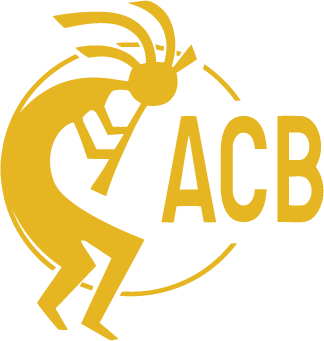
I’ve been a member of the “EMC Society” for several decades, working and communing with fine folks aplenty. This throwback goes back a while and features our EMCS Historian Dan Hoolihan, who is keen to protect the memories of our Society’s glorious past and contributions from our hero, the late Leonard Thomas. Leonard was a long-time archivist and maintained a museum of radios, ephemera and memories, donating his epic collection for further reflection and insight into our community’s shared past.
(And a special nod to EMCS’ Social Media scion, Rachel Norrod, who reminded me that this bit was previously published in the Society’s EMC Magazine a dozen or so years ago. Thank you!)
Leonard Keeps Giving: Another Dig Into The Past
Mike Violette
About thirty minutes from the National Archives is a humble storage complex at Tysons Corner, an architectural inversion of the federalist-style granite building that cradles the scriptures from the founding of our country. For the EMC Society, this humble Virginia facility holds the recovered scrolls from our early summer trip to Leonard Thomas’ inner sanctum, a critical link to the history of our group’s founding.
As Summer reluctantly left the stage to Fall on a brilliant blue-sky Friday, Dan Hoolihan, EMCS Historian, continued his hunt for the near-legendary, possibly mythical list of the names of the original EMC Founders. Words have been whispered, theories proposed and emails exchanged: somewhere in the first secretary’s earthly possessions was that fabled List. That morning, fortified by a life-shortening, but delicious egg and sausage and swiss cheese breakfast sandwich, lovingly assembled on a fresh multi-grain brioche and washed down with a truly above average cup of coffee, we advanced like knights in search of the Holy Grail, but with maybe less ecclesiastical fervor and certainly less clunking, and not on steeds, but in four cylinder sedans.
As traffic in Tysons wound up to its usual frenetic and loathsome neck-muscle tightening swirl, we set forth off to find it: The List.

Once again, we found much more.
Dan’s reverent guidance was simple and direct, I posit not unlike Lewis Leakey’s gentle words to his staff as the first indications of the fossilized bones of Australopithecus afarensis or Lucy were swept clean of eons of limbo. “Careful lads,” I imagine him saying. “The smallest scrap might hold the biggest clue.”
Maybe we would be as lucky and our Lucy would be brought to light.
It was with measured optimism that we pulled into a cookie-cutter orange storage compay where people keep their treasures that they rarely visit and have mostly forgotten: toys they no longer play with and clothes that don’t fit and appliances that will never again feel a crackling glow in their electrical circulatory system.
Not unlike Howard Carter’s feeling of elation upon discovering the resting place of Tutankhamen (ok, ok it’s a stretch), we gently coaxed the cypher lock open.

With a soft click the door yielded and we entered the climate-controlled tomb of unloved prized possessions.
With a clattering rattle, the overhead metal door was flung open and light bathed a wondrous scene. We had to pause and catch our breath, brows wet, despite the conditioned air of the place. My nostrils filled with the sweet smell of timeless nostalgia; the air swirled mysteriously overhead as a motor kicked to life someplace (did I catch a whiff of mimeograph ink?). I reeled for a moment. In those lovely white cardboard sarcophagi was the march of time, possibly five decades or more: pencil, pen, carbon paper, Xerox, thermal facsimile, so many ways of communicating.

Again back to Carter: I imagined him studying the cuneiform and hieroglyphs under flickering lights. If only we could douse the glaring incandescent lights and hold torches to our treasure, we might then understand fully that thrill. Unfortunately, the Fairfax County Fire Department generally frowns upon the possession and burning of kerosene-soaked torches in enclosed spaces.
The Forties
We set to work, opening the boxed files as hundreds of voices of EMC past fairly chattered. We searched each and every file in pursuit of the List. At another time, with more leisure, each set of documents could entertain and inform for hours. But time was against us.
Did we fear that the precious documents would crumble to dust? Or was there a meticulous but benign spirit whose essence shadowed the fifty years of carefully-typed minutes and meetings? Did the engineers who invented the devices in the catalogs and specifications cry out in haunting voices: “Remember My Oscillator. I Have Created It!”? Or did we feel the ghost of a WWII Navy Technician, forever bound to the Earth, hopelessly searching for the Spare Parts Catalog for Panoramic Radio Receivers, published nineteen forty five? No, no–No such thing, all imagined. Dan had to hop a plane at noon.
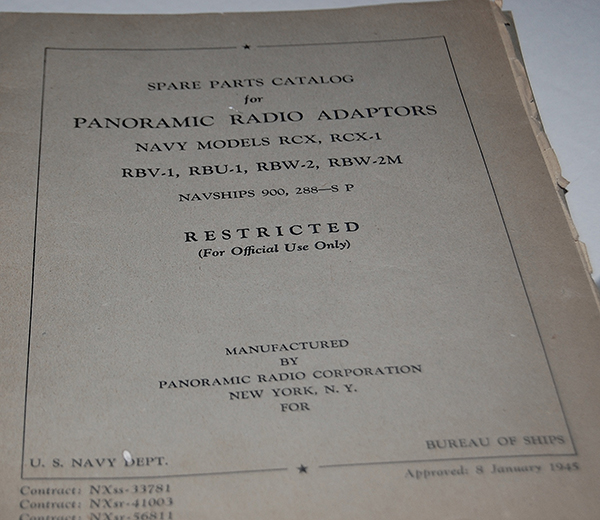
Our Plutarch remained steady at his task and muttered quietly, reading off the names of the Founders and followers of the EMCS, lost in a certain reverie as he scanned minutes of years of meetings and various correspondences, reading the names: Fisher, O’Neill, Nichols, Kesselman, White, Showers, Heirman, Schlicke, so many others.
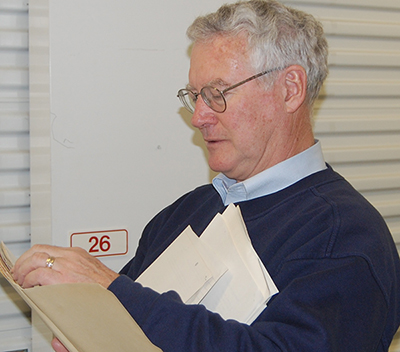
We must be close to finding the Keystone.
Meanwhile, I had the good fortune to sift through some of the collection: correspondence, professional and semi-personal collections of articles, standards and publications.
The first ANSI C95.1 was about five pages long. Ten milliwatts per cm squared.
Curiously, a letter written to a young Mr. Thomas slipped from a manila folder and floated to the floor. Dated March 18, 1949 on Bell Telephone Laboratories letterhead, carefully typed on a Remington or Smith-Corona Manual, it read, in part. (I imagine Leonard’s thrill: Ah, publication!).
“Dear Mr. Thomas,
I am glad to inform you that your paper “Interference Reduction” has been accepted for presentation at a meeting sponsored by Commission 4 of the URSI in Washington on May 2-3. You will be informed of detailed arrangements later.”
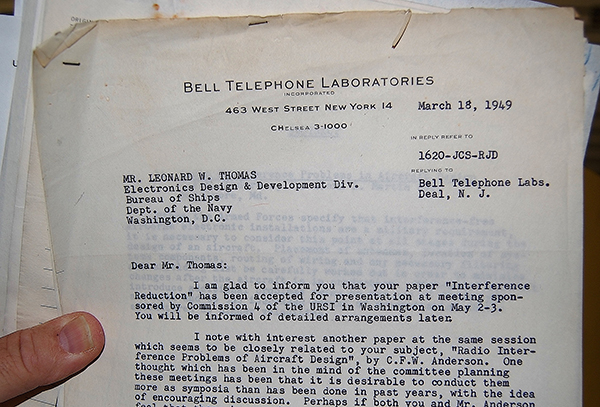
Interference? Back in 1949? The transistor was still in swaddling clothes! But, I am reminded: The more things change, &c. And as to the pursuit of the paper: “Interference Reduction”, truthfully, I am not unhappy that Mr. Thomas’ paper did not reduce all of the interference, for, lo it is often a lonely and painful pursuit, were it not for interference, we would not be slabbing words on a page for Ms. O’Neil’s journal.
The Fifties
Advancing my search a decade and more than slightly off-task, I marveled at the deft innovation of the motor-operated “Mechanical Sweep Drive” from the General Radio Catalog which “attaches to knobs, dials or shafts” to speed EMC tests. Even in its infancy, a certain tedium accompanied our work. Confession: It has not been too long since we rigged an electric drill to our venerable HP 8672 signal generator to accomplish the same thing. (And a paper clip jammed in the frequency increment button does the trick on an 8656.) As to the frequency standard, I can’t imagine calculating the uncertainty accompanying a calibration on the four hundred pound, seven foot rack of wire, knobs and tubes.
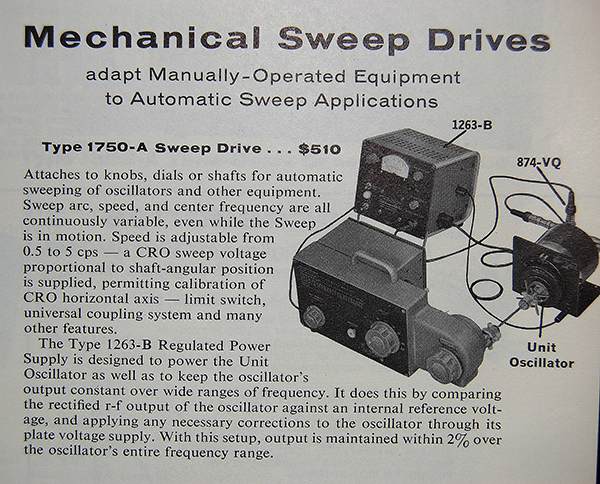
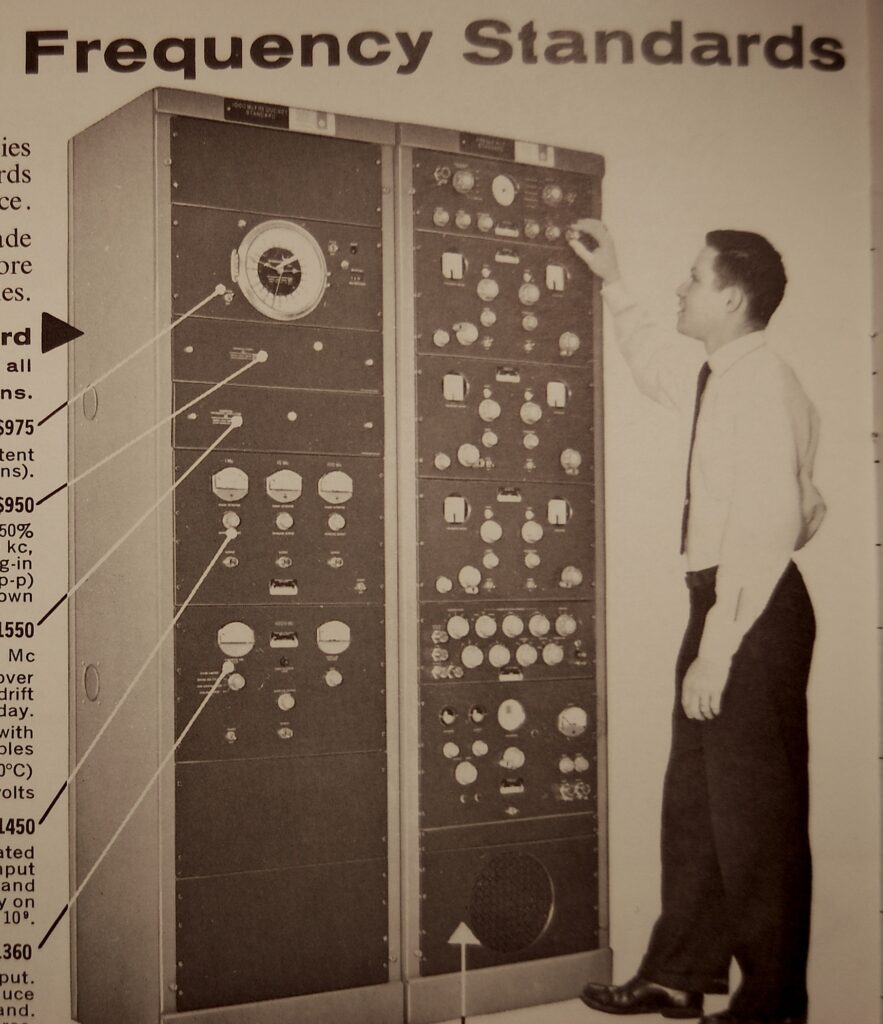
A third box produced a yellowing kraft-paper envelope which granted us some more gold, complete with black and white photographs. Locale: off the coast of California. Maybe a studied propeller-head reader of this journal can weigh in on the make and model of the airplane while the rest of us can marvel at the RF rig that this young engineer is using to do his EMC thing.
Check out the “graphical interface”: pre-pan display; pre-Polaroid; post-papyrus.

We’re not sure who this pioneer is (Leonard, himself, perhaps?), but the caption of the photo reads “ambient test” and this particular project looked like a site survey or RF system performance measurement of some kind; in the envelope were multiple aerial photos taken through the window of the small tail-dragger in the background.
The Sixties
The US was firmly in the grip of the hysteria of the Cold War and apocalyptical fear gripped the pen of the author of the article on EMC in the New Englander, a general-interest publication. In the October 1963 edition it carried an ominous article on EMC, likening the problem of RF Interference to that unveiled in Rachel Carson’s book of that time on the environment: Silent Spring. The bent of the article was that the uncontrolled growth in radio frequency emissions was going to leave the spectrum a hostile and toxic place. There are some amusing snippets in the piece, including likening RF propagation to nuclear ‘fissing’, to wit:
“…when the static energy travels and snowballs, picking up more energy and gathering strength as it goes, ending up miles from its original source, that can be dangerous…” Hmmm.
And “Another Silent Spring may be in the making.” Yikes! The article goes on its exposé of the various levels of interest, ignorance and denial that are the human condition, and again, the more things change..“As a result of man’s inventiveness and passion for miniaturization, products emitting electrical energy have been made even smaller and smaller–and packed closer to other sources of spurious emission”
and finally, a time-proved statement:
“The FCC staff is overworked and understaffed.”
In the fine but faulty rhetoric of the Post-McCarthy era, it speaks of “an EMC-riddled atmosphere.”
If that were true, we’d all be looking for jobs. Too much EMC? Let us pray not!

But smug observations aside, it’s an interesting read, for sure, and talks about the origins of the Electromagnetic Compatibility Analysis Center (ECAC) in Annapolis. One interesting paragraph harkens to the early formation of the EMC Society. “…in 1957 the Professional Group on Radio Frequency Interference of the Institute of Radio Engineering was formed and has now changed its name to the Professional Technical Group on Electromagnetic Compatibility (PTGEMC) in order to include the entire interference field.”
Aha! Another click of the Rubik’s Cube. We can’t be far-off…
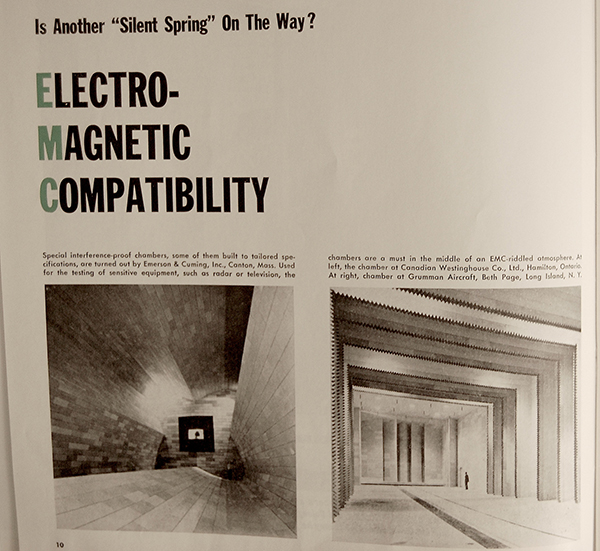
The Seventies
But before we advance to the present, we have to pay homage to one more decade. Tripping along through the sixties we welcomed the engineering community to the summer of Love and and the Groovy EMC Society with the “1970 International Symposium on EMC”. That is some Aquarius cool, the Expanding Science of EMC. WOW! Let’s jump in the hot tub, celebrate the next few decades of discovery (and hope there’s no leakage current).
Engineers in bell-bottoms.
Far out!
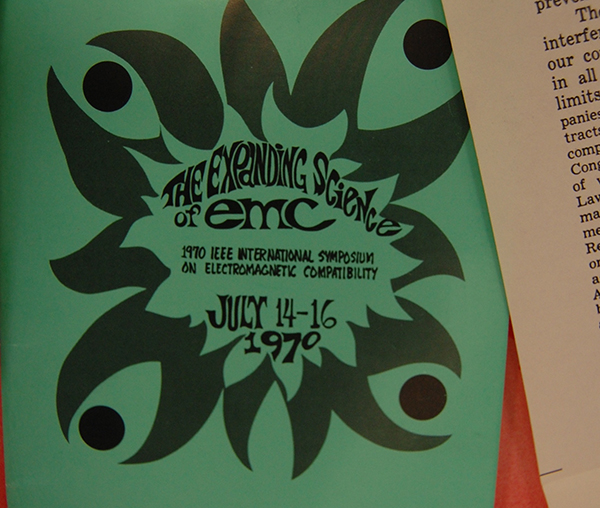
List Ho!?
At this point, our time was running out and we hadn’t found what we were looking for and the effects of the morning’s coffee had worn off. We decided to stop after one more box and leave the rest to another time when fortuitously a folder with title: “EMC History” was pulled from the fourth box. Dan’s hands trembled as his eyes fell to handwritten sign-in sheets and finally, perhaps, the Grail itself–a transcribed list of names on graph paper.
“I think we may have it,” Dan said, his laconic mid-western manner thinly and insufficiently covering his excitement. “I’ll write this down and see if our members recognize these names.”
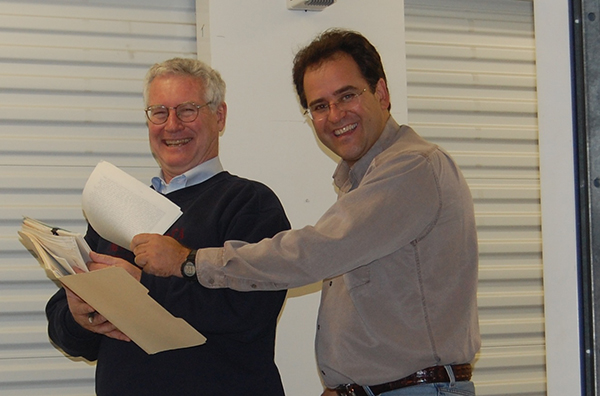
Buoyed, but cautious, we re-sealed the tomb and left, vowing to return and sift through the archives once more, should our mission not be complete.
Dan made his plane.
Thanks again Mr. Thomas.
Epilogue
Well, is it the list? Dan, what did you find?
Bibliography
The Leonard Thomas Archives. 1940s-2006
The New Englander. The New England Council for Economic Development. October 1963.
